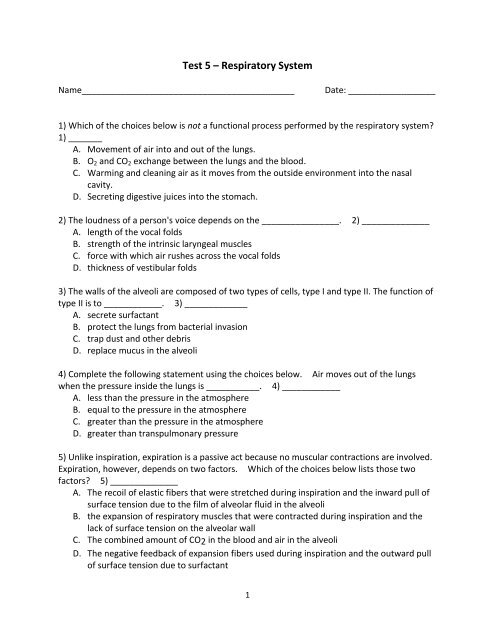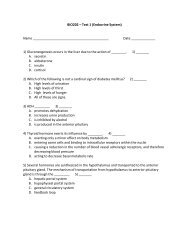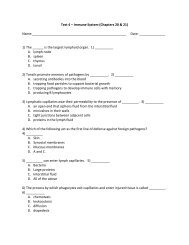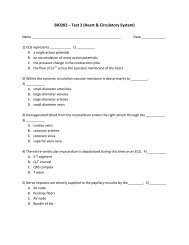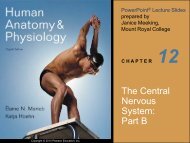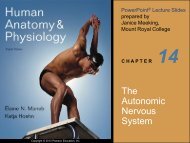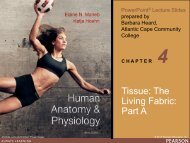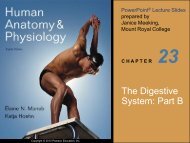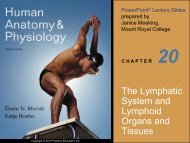Test 5 â Respiratory System - Next2Eden
Test 5 â Respiratory System - Next2Eden
Test 5 â Respiratory System - Next2Eden
You also want an ePaper? Increase the reach of your titles
YUMPU automatically turns print PDFs into web optimized ePapers that Google loves.
<strong>Test</strong> 5 – <strong>Respiratory</strong> <strong>System</strong><br />
Name____________________________________________<br />
Date: __________________<br />
1) Which of the choices below is not a functional process performed by the respiratory system?<br />
1) _______<br />
A. Movement of air into and out of the lungs.<br />
B. O 2 and CO 2 exchange between the lungs and the blood.<br />
C. Warming and cleaning air as it moves from the outside environment into the nasal<br />
cavity.<br />
D. Secreting digestive juices into the stomach.<br />
2) The loudness of a person's voice depends on the ________________. 2) ______________<br />
A. length of the vocal folds<br />
B. strength of the intrinsic laryngeal muscles<br />
C. force with which air rushes across the vocal folds<br />
D. thickness of vestibular folds<br />
3) The walls of the alveoli are composed of two types of cells, type I and type II. The function of<br />
type II is to ____________. 3) _____________<br />
A. secrete surfactant<br />
B. protect the lungs from bacterial invasion<br />
C. trap dust and other debris<br />
D. replace mucus in the alveoli<br />
4) Complete the following statement using the choices below. Air moves out of the lungs<br />
when the pressure inside the lungs is ___________. 4) ____________<br />
A. less than the pressure in the atmosphere<br />
B. equal to the pressure in the atmosphere<br />
C. greater than the pressure in the atmosphere<br />
D. greater than transpulmonary pressure<br />
5) Unlike inspiration, expiration is a passive act because no muscular contractions are involved.<br />
Expiration, however, depends on two factors. Which of the choices below lists those two<br />
factors? 5) ______________<br />
A. The recoil of elastic fibers that were stretched during inspiration and the inward pull of<br />
surface tension due to the film of alveolar fluid in the alveoli<br />
B. the expansion of respiratory muscles that were contracted during inspiration and the<br />
lack of surface tension on the alveolar wall<br />
C. The combined amount of CO2 in the blood and air in the alveoli<br />
D. The negative feedback of expansion fibers used during inspiration and the outward pull<br />
of surface tension due to surfactant<br />
1
6) Which of the following maintains the patency (openness) of the trachea? 6)____________<br />
A. cartilage rings<br />
B. pseudostratified ciliated epithelium<br />
C. surface tension of water<br />
D. surfactant<br />
7) Intrapulmonary pressure is the ______________. 7) ______________<br />
A. pressure within the alveoli of the lungs<br />
B. pressure within the pleural cavity<br />
C. negative pressure in the intrapleural space<br />
D. difference between atmospheric pressure and respiratory pressure<br />
8) Bacteria or other particulate debris contained within inspired air are removed or destroyed<br />
by _______.<br />
A. mucus<br />
B. vibrissae (nose hairs)<br />
C. stomach acid<br />
D. all of the above<br />
9) The structure at the most posterior aspect of the soft palate which prevents food and liquid<br />
from going into the nasal cavity is called the ____________. 9) ___________<br />
A. nasal conchae<br />
B. uvula<br />
C. Eustachian tube<br />
D. posterior nasal aperture<br />
10) Surfactant helps to prevent the alveoli from collapsing by ____________. 10)<br />
____________<br />
A. protecting the surface of alveoli from dehydration and other environmental variations<br />
B. interfering with the cohesiveness of water molecules, thereby reducing the surface<br />
tension of alveolar fluid<br />
C. warming the air before it enters<br />
D. humidifying the air before it enters<br />
11) The respiratory membrane ___________. 11) ____________<br />
A. is involved in internal respiration<br />
B. is just another name for alveolar tissue<br />
C. is the thickness of a piece of tissue paper<br />
D. is composed of alveolar epithelial cells and capillary endothelial cells jointly held<br />
together by a fused basement membranes<br />
2
12) The function of alveolar type I cells is _____________. 12) _____________<br />
A. to allow rapid diffusion of respiratory gases<br />
B. phagocytosis of dust particles<br />
C. to produce surfactant<br />
D. to adhere to pulmonary capillaries<br />
13) Occasionally food or liquids will “go down the wrong pipe,” initiating a cough reflex.<br />
Which structural barrier has been breached if this happens? 13) ___________<br />
A. Laryngopharynx<br />
B. Uvula<br />
C. Epiglottis<br />
D. Glottis<br />
14) Nerve impulses from ________ will result in a regular rhythm of inspiratory and expiratory<br />
signals.<br />
14) ____________<br />
A. the preoptic nucleus of the hypothalamus<br />
B. the chemoreceptor center<br />
C. Broca's center<br />
D. the ventral respiratory group<br />
15) In the plasma, the quantity of oxygen in solution is __________. 15) ___________<br />
A. about equal to the oxygen combined with hemoglobin<br />
B. greater than the oxygen combined with hemoglobin<br />
C. about 1.5% of the total amount of oxygen carried in the blood<br />
D. not present except where it is combined with carrier molecules<br />
16) Which of the following is an untrue statement? 16) ____________<br />
A. The largest fraction of carbon dioxide transported in the blood is in the form of<br />
bicarbonate.<br />
B. Carbon dioxide is transported in the blood by binding hemoglobin at the heme groups.<br />
C. Carbonic anhydrase plays a central role in reversibly converting carbon dioxide into<br />
carbonic acid.<br />
D. The bicarbonate buffer found in blood is a major buffering system in maintaining proper<br />
blood pH.<br />
17) During an asthma attack, bronchioles become severely _______. Taking epinephrine<br />
causes them to _______. 17) __________<br />
A. constricted; dilate<br />
B. dilated; constrict<br />
C. mucus-filled; empty of mucus<br />
D. both a and c<br />
3
18) Central Chemoreceptors _____________. 18) ___________<br />
A. are located in the aortic arch and carotid bodies<br />
B. are exquisitely sensitive to increases in H+ concentrations in the brain<br />
C. when activated cause increased respiration to “blow off” CO 2<br />
D. B and C<br />
19) Which of the following is true about lung cancer? 19) _____________<br />
A. There is no connection between smoking and the likelihood of lung cancer.<br />
B. Lung cancer is the leading cause of cancer death in both men and women.<br />
C. There are no new therapies being developed for lung cancer.<br />
D. Tuberculosis is a form of lung cancer caused by smoking.<br />
20) ____________ is an infectious lung disease caused by inhaling a mycobacterial pathogen.<br />
20) _________<br />
A. Asthma<br />
B. Tuberculosis<br />
C. <strong>Respiratory</strong> allergies<br />
D. Emphysema<br />
21) In healthy lungs the greatest resistance to air flow occurs in ______________. 21)<br />
_____________<br />
A. the main bronchi<br />
B. the medium-sized bronchi<br />
C. the respiratory bronchioles<br />
D. the alveolar sac<br />
22) Even the most forceful exhalation leaves air in the lungs; this is called the ______ and is<br />
needed to _______. 22) __________<br />
A. tidal volume; acquire adequate O2<br />
B. vital capacity; remove adequate CO2<br />
C. functional residual capacity; keep alveoli patent<br />
D. residual volume; keep alveoli patent<br />
23) Tidal volume is the amount of air ___________. 23) ___________<br />
A. forcibly expelled after normal expiration<br />
B. that moves into and then out of the lungs with each breath during normal quiet<br />
breathing<br />
C. remaining in the lungs after forced expiration<br />
D. inhaled after normal inspiration<br />
4
24) Infant respiratory distress syndrome occurs because premature infants lack the ability to<br />
produce _______, which _______. 24) __________<br />
A. mucus; traps bacteria<br />
B. cilia; clear mucus from the trachea<br />
C. surfactant; lowers surface tension<br />
D. alveoli; causes them to become hypoxic<br />
25) For an average person in a resting state the minute ventilation is approximately _________.<br />
25) ______<br />
A. 500 mls of air<br />
B. 2000 mls of air<br />
C. 6 L of air<br />
D. 9 L of air<br />
26) Hemoglobin molecules are fully saturated when bound to ____ molecule(s) of O2.<br />
A. 1<br />
B. 2<br />
C. 3<br />
D. 4<br />
27) Surface area in the nasal cavity is increased by the presence of ________.<br />
27) ______<br />
A. olfactory folds<br />
B. conchae<br />
C. microvilli<br />
D. soft palate<br />
28) Red blood cells contain the enzyme _____, which catalyzes the formation of carbonic acid.<br />
28 _________<br />
A. carbonic anhydrase<br />
B. carbon dioxide acidase<br />
C. oxidase<br />
D. catalase<br />
29) <strong>Respiratory</strong> control centers are located in the ________. 29) _________<br />
A. midbrain and medulla<br />
B. upper spinal cord and medulla<br />
C. medulla and pons<br />
D. pons and midbrain<br />
5
30) The amount of air that can be inspired above the tidal volume is called ________. 30)<br />
_________<br />
A. expiratory reserve<br />
B. reserve air<br />
C. vital capacity<br />
D. inspiratory reserve<br />
31) Which statement about CO 2<br />
is incorrect? 31) __________<br />
A. CO2 concentrations are greater in venous blood than arterial blood.<br />
B. CO2 accumulation in the blood is associated with a decrease in pH.<br />
C. CO2 concentration in the blood is decreased by hyperventilation.<br />
D. CO2 dissolved in plasma is the most abundant storage site for this gas in blood.<br />
32) Oxygen and carbon dioxide are exchanged in the lungs and through all cell membranes by<br />
________. 32) ___________<br />
A. filtration<br />
B. diffusion<br />
C. osmosis<br />
D. passive transport<br />
33) The auditory tube (Eustachian tube) drains into the __________. 33) ___________<br />
A. nasopharynx<br />
B. oropharynx<br />
C. laryngopharynx<br />
D. Nasal conchae<br />
34) This structure prevents food from entering the airway. 34) ___________<br />
A. Vestibular fold<br />
B. Urula<br />
C. Laryngopharynx<br />
D. Epiglottis<br />
35) Which respiratory-associated muscles would relax/contract if you were to inhale? 35)<br />
_____________<br />
A. diaphragm contracts, external intercostals would contract<br />
B. diaphragm contracts, internal intercostals would relax<br />
C. internal intercostals would contract and the abdominal muscles would relax<br />
D. external intercostals would contract and diaphragm would relax<br />
6
36) With regards to the esophagus and the trachea which statement or statements are true?<br />
36) ___________<br />
A. The esophagus is in front of the trachea<br />
B. The trachea is comprised of C shaped cartilages that allow the esophagus to push into<br />
the tracheal lumen as food passes by<br />
C. The tracheal lumen is lined with ciliated epithelium<br />
D. B and C<br />
37) The respiratory membrane is a combination of ____________. 37) ___________<br />
A. respiratory bronchioles and alveolar sacs<br />
B. atria and alveolar sacs<br />
C. respiratory bronchioles and alveolar ducts<br />
D. alveolar and capillary walls and their fused basement membranes<br />
38) During exercise ___________. 38) _____________<br />
A. the minute volume stays the same<br />
B. arterial PO 2 and PCO 2 remain constant<br />
C. psychological stimuli play a small role<br />
D. the rate but not the depth of breathing increases<br />
39) The nose serves all the following functions except ___________. 39) ___________<br />
A. warming and humidifying the air<br />
B. cleansing the air<br />
C. as the initiator of the cough reflex<br />
D. as a passageway for air movement<br />
40) The membrane that adheres to the outer surface of the lungs is the: 40) ______<br />
A. respiratory membrane<br />
B. visceral pleura<br />
C. parietal pleura<br />
D. parietal serosa<br />
41) People that live at high altitude go through a process of acclimatization. Changes include:<br />
41) ________<br />
A. A decrease in the density of capillaries in the tissue beds<br />
B. Increased hematocrit<br />
C. Increased resting minute volume<br />
D. B & C<br />
42) A decrease in pH will have what effect on the respiration rate? 42) __________<br />
A. Decrease<br />
B. Increase<br />
C. No effect<br />
D. No effect unless lung damage is present<br />
7
43) The underlying problem with emphysema is that __________. 43) __________<br />
A. there is a buildup of mucous<br />
B. it is generally caused by smoking<br />
C. it is a bronchitis like condition due to a viral infection<br />
D. it involves the progressive destruction of the alveolar walls<br />
44) The pressure exerted by each type of gas in a gas mixture is the __________ of that gas.<br />
44) __________<br />
A. partial force<br />
B. partial percentage<br />
C. partial volume<br />
D. partial pressure<br />
45) With regards to the esophagus and the trachea which statement or statements are true?<br />
45) ___________<br />
A. The esophagus is in front of the trachea<br />
B. The trachea is comprised of C shaped cartilages that allow the esophagus to push into<br />
the tracheal lumen as food passes by<br />
C. The tracheal lumen is lined with ciliated epithelium<br />
D. B and C<br />
8
1) D<br />
2) C<br />
3) A<br />
4) C<br />
5) A<br />
6) A<br />
7) A<br />
8) D<br />
9) B<br />
10) B<br />
11) D<br />
12) A<br />
13) C<br />
14) D<br />
15) C<br />
16) B<br />
17) A<br />
18) D<br />
19) B<br />
20) B<br />
21) B<br />
22) D<br />
23) B<br />
24) C<br />
25) D<br />
26) D<br />
27) B<br />
28) A<br />
29) C<br />
30) D<br />
31) D<br />
32) B<br />
33) A<br />
34) D<br />
35) A<br />
36) C<br />
37) D<br />
38) B<br />
39) C<br />
40) B<br />
41) D<br />
42) B<br />
43) D<br />
44) D<br />
45) C<br />
9


